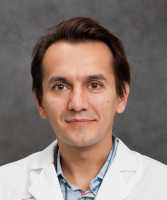23 Nov New Imaging Technology Can Measure Potential for Vision Loss in Neurofibromatosis
MedicalResearch.com Interview with:
Marius George Linguraru, DPhil, MA, MB
Principal Investigator
Associate Professor of Pediatrics and Radiology
George Washington University School of Medicine and Health Sciences
Children’s National Health System
Washington, DC
MedicalResearch.com: What is the background for this study? What are the main findings?
Response: Neurofibromatosis type 1 (NF1) is the most common cancer predisposition syndrome affecting the central nervous with an incidence of one in 3,000 births. Nearly one in five children with NF1 develops an optic pathway glioma (OPG), a low-grade tumor of the anterior visual pathway (i.e., optic nerves, chiasm and tracts). These tumors are not amenable to surgical resection and can cause permanent vision loss ranging from a mild decline in visual acuity to complete blindness. Only half of children with NF1-OPGs will experience vision loss, typically between 1 to 6 years of age. The other half will never lose vision or require treatment.
All previous studies have consistently demonstrated that the change in NF1-OPG size is not related to the clinical outcome. For example, the optic pathway glioma size may be stable or even decrease, yet the vision will decline. Alternatively, the OPG size may increase, yet the clinical outcome remains stable or even improves. As no imaging or clinical features can identify which children with NF1-OPGs will ultimately lose vision, clinicians struggle to follow these children and decide when to intervene.
We used quantitative imaging technology to accurately assess in magnetic resonance imaging (MRI) the total volume of OPGs in NF1. We also determined the retinal nerve fiber layer thickness in these children, a measure of axonal degeneration and an established biomarker of visual impairment. The results were outstanding, as we showed for the first time that the volume of an optic pathway glioma is indeed correlated with the likelihood of vision loss in children with Neurofibromatosis type 1.
MedicalResearch.com: What should readers take away from your report?
Response: This is the first time that a study has been able to definitively connect tumor volume and vision loss for children with NF1-OPGs. Measuring the tumors in a precise, systematic manner, along with knowing how they grow, is the first step in recognizing which children are at highest risk for vision loss and to potentially identifying an opportunity to initiate treatment before they suffer any visual symptoms. It is equally important to recognize early and accurately which young children are not at risk for vision loss and reduce unnecessary surveillance imaging with sedation.
Caring for young and vulnerable patients with complex and uncommon tumors requires a multidisciplinary approach, like we did in this study, where a team of neuro-ophthalmologists, oncologists and imaging specialists worked closely together.
MedicalResearch.com: What recommendations do you have for future research as a result of this study?
Response: Comprehensive volumetric, and automated if possible, measurements of tumors will increase not only the understanding of the risk they imply for patients, but will also better inform clinical trials about the efficacy of therapies.
MedicalResearch.com: Thank you for your contribution to the MedicalResearch.com community.
Citation:
Optic pathway glioma volume predicts retinal axon degeneration in
neurofibromatosis type 1
Robert A. Avery, DO, MSCE, Awais Mansoor, PhD, Rabia Idrees, BS, Carmelina Trimboli-Heidler, CDOS, Hiroshi Ishikawa, MD, Roger J. Packer, MD and
Marius George Linguraru, DPhilPublished online before print November 4, 2016,
doi: http://dx.doi.org/10.1212/WNL.0000000000003402Neurology 10.1212/WNL.0000000000003402
Note: Content is Not intended as medical advice. Please consult your health care provider regarding your specific medical condition and questions.
More Medical Research Interviews on MedicalResearch.com
[wysija_form id=”5″]
Last Updated on November 23, 2016 by Marie Benz MD FAAD

